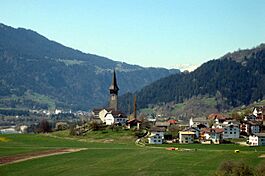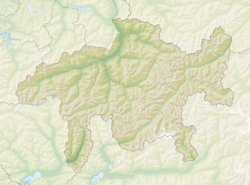Sagogn facts for kids
Quick facts for kids
Sagogn
|
||
|---|---|---|
 |
||
|
||
| Country | Switzerland | |
| Canton | Graubünden | |
| District | Surselva | |
| Area | ||
| • Total | 6.92 km2 (2.67 sq mi) | |
| Elevation | 779 m (2,556 ft) | |
| Population
(Dec 2020 )
|
||
| • Total | 736 | |
| • Density | 106.36/km2 (275.5/sq mi) | |
| Postal code |
7152
|
|
| Surrounded by | Castrisch, Falera, Flims, Laax, Schluein, Valendas, Versam | |
Sagogn is a small town, also called a municipality, in Switzerland. It is located in the Surselva Region in the canton of Graubünden. Sagogn is known for its beautiful scenery and interesting history.
Contents
History of Sagogn
Sagogn has a very long history! It was first mentioned in old records way back in the year 765 AD. Back then, it was known by the name Secanio.
Geography of Sagogn
Sagogn covers an area of about 7 square kilometers (2.7 square miles). A large part of this land, about 23%, is used for farming. Even more, nearly 60%, is covered by forests. About 5% of the land has buildings or roads. The rest, about 12%, is made up of rivers, glaciers, or mountains.
The town is located on a northern slope, high above the Vorderrhein river. It sits on the bank of an area called Gruob, or Foppa. Sagogn is divided into two main parts: Innerdorf (which means Vitg Dadens) and Ausserdorf (which means Vitg Dado). Until 1943, the town was known by its German name, Sagens.
People of Sagogn
Sagogn has a population of about 700 people. A small part of the population, around 6.6%, are people from other countries. Over the last 10 years, the number of people living here has slightly decreased.
Most people in Sagogn speak Romansh, which is a special language spoken in parts of Switzerland. About 57% of the people speak Romansh. The second most common language is German, spoken by about 41% of the people. The official language here is the Sursilvan dialect of Romansh.
Sagogn has people of all ages. About 10% of the population are children under 9 years old. Teenagers, aged 10 to 19, make up about 15% of the population. The rest are adults and older people.
Many people in Sagogn are well-educated. About 75% of adults have completed high school or gone on to higher education like university.
Jobs and Economy
Sagogn has a low unemployment rate, which means most people who want to work can find jobs. In 2005, there were 13 people working in farming and related businesses. 22 people worked in manufacturing and construction. The largest number of jobs, 33 people, were in the service industry. This includes jobs like working in shops, hotels, or offices.
Historical Population Changes
The number of people living in Sagogn has changed a lot over the years. Here's how the population has looked at different times:
| year | population |
|---|---|
| 1803 | 399 |
| 1850 | 535 |
| 1900 | 405 |
| 1950 | 492 |
| 1970 | 383 |
| 1990 | 611 |
| 2000 | 597 |
Important Historical Sites
Sagogn is home to some very important historical places. These are recognized as heritage sites of national significance. They include the Church of S. Maria and the ancient settlement, medieval castle, and church at Schiedberg Castle/Bregl da Haida.
Church of S. Maria
The Church of S. Maria was built in 1634. However, its church tower is much older, built in 1449. The church has a main area called a nave with three sections. It also has a rectangular choir (where the singers sit) and a transept (a part that crosses the main church). There are also two small side chapels.
The beautiful paintings on the ceiling and walls were created in 1639 by an artist named Giov. Batt. Macholino. The main altars inside the church are from around the same time.
Schiedberg Castle and Bregl da Haida
The castle site at Schiedberg has been used by people since prehistoric times, long before written history! The castle was important because it helped protect a trade route called the Lukmanier Pass.
Near the castle, there's a church at Bregl da Haida. This church was first built in the 5th century. Later, in the 7th century, a new church was built in the Carolingian style. This church had one main room and a special horseshoe-shaped area called an apse. It was mentioned in a document from 765 as the Columbans church. This church might have been a private chapel for a powerful family called the Viktoriden, who lived in a nearby manor house.
Getting Around
The Valendas-Sagogn train station is about 2.3 kilometers (1.4 miles) away from the village of Sagogn. This station is on the Rhaetian Railway line, which connects the cities of Chur and Disentis.
Images for kids
See also
 In Spanish: Sagogn para niños
In Spanish: Sagogn para niños














